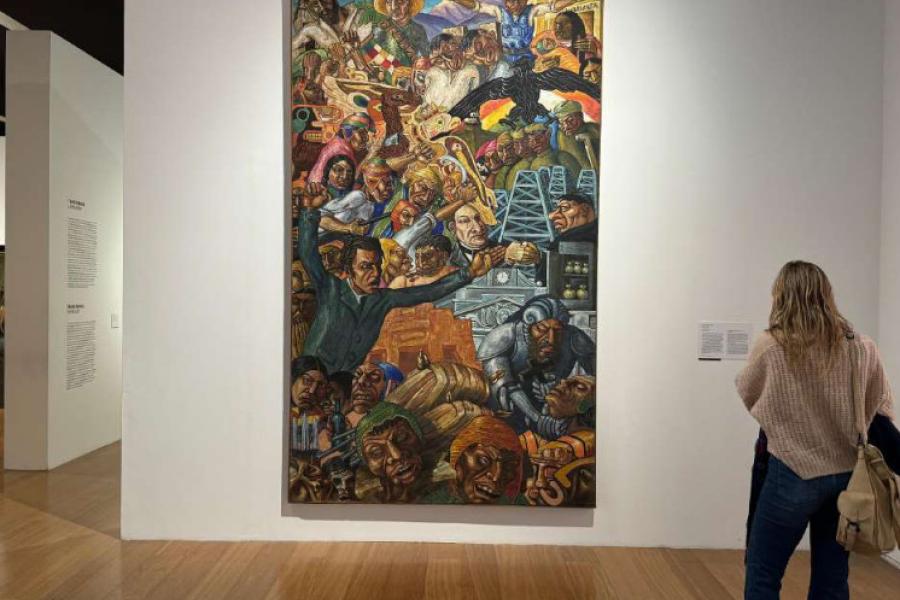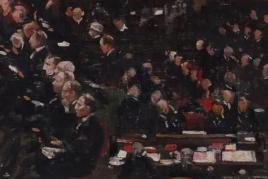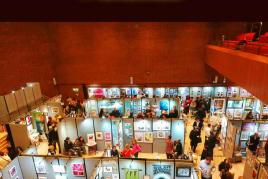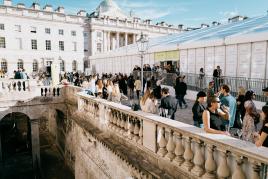Three US Museums and one Latin…
Twelve Works of Art by Indigenous Bolivian Artist Alejandro Mario Yllanes
 Alejandro Mario Yllanes - Mit freundlicher Genehmigung von: benelwes.co.uk
Alejandro Mario Yllanes - Mit freundlicher Genehmigung von: benelwes.co.ukWer: Ben Elwes Fine Art
Was: Presse
Wann: 16.08.2024
Three US Museums and one Latin American private collection have acquired important works by Indigenous Bolivian artist Alejandro Mario Yllanes (1913-c.1960) from Ben Elwes Fine Art's London Art Week summer and winter exhibitions in 2023. Eduardo Costantini, a private collector, founder and honorary president of MALBA, acquired a major work by Yllanes for his private collection and will be on loan to the museum and exhibited in "Third eye. The Costantini Collection in Malba." The twelve works include a newly discovered self portrait by the artist and two monumental paintings which will go on view at The Metropolitan Museum of Art, the Bowdoin College Museum of Art (BCMA), the Frances Lehman Loeb Art Center, Vassar College and MALBA in Buenos Aires.
During the summer of 2023 the focus of the LAW exhibition at Ben Elwes Fine Art was on Yllanes' works of paper, while his monumental paintings were on view in the autumn and winter. The exhibition was accompanied by a talk between Dr. Michele Greet (Professor of modern Latin American art history at George Mason University) and Carolina Scarborough (Art Professional specialising in Latin American art) discussing Yllanes' unique oeuvre. The talk is available on LAW's YouTube channel and resulted in the discovery of a further self portrait by the artist.
A socially conscious artist, Alejandro Mario Yllanes drew inspiration from Mexico’s muralists and he created a compelling and powerful body of work, including paintings and works on paper, before he disappeared sometime around 1950. Yllanes was born in 1913 to an Aymara mother and mixed-race father. Primarily self-taught, he embraced modernism while drawing inspiration from Bolivia’s pre-Hispanic Tiwanaku culture to develop a distinct “tahuanacota” approach in his socially conscious art. As an advocate for Bolivia’s marginalised Indigenous peoples, Yllanes created prints, murals, and paintings that confronted the economic exploitation and mistreatment they endured. This activist art brought him recognition across Latin America and exchanges with famed Mexican artists including José Clemente Orozco, David Alfaro Siqueiros, and particularly Diego Rivera, who became a supporter and mentor. During his time in Mexico, a major exhibition of his work was held at the Palace of Fine Arts in Mexico City in 1946.
By the late 1940s, Yllanes had relocated to the United States, in part with backing from a Guggenheim Memorial Foundation grant. He continued to produce works, which were acquired by the Museum of Modern Art, the Brooklyn Museum, and the New York Public Library. However, his career was cut short under obscure circumstances around 1950: he vanished, leaving behind a trove of art works that were subsequently cared for by his landlord, and were later acquired by private collectors who recognized the importance of the material and the need to properly preserve it. Though overlooked for decades, recent scholarship is underscoring Yllanes’ lasting influence as both a revolutionary artist and champion of Indigenous resistance movements.
Eduardo Costantini, founder and honorary president of the Museum of Latin American Art of Buenos Aires, states: "Yllanes, for me, was an amazing discovery, I couldn’t believe to find a modern Latin American artist of this high quality after collecting for more than 40 years. I am truly very happy to be able to acquire this great masterpiece, Tragedia del Pongo, of 1932 to be exhibited at MALBA this year in dialogue with other masters of his generation, as well as other native Latin American artists from the contemporary period." The painting is arguably the artist’s masterpiece and his largest work at nearly three metres tall.
The Bowdoin College Museum of Art (BCMA) has acquired Estaño Maldito (Cursed Tin) of 1937, an important monumental painting by Alejandro Mario Yllanes. Executed after Bolivia’s defeat in the Chaco War, the work offers a scathing portrayal of the dire conditions faced by Indigenous miners in the nation’s lucrative tin industry. In addition to the painting, the Museum has also acquired Elegia of 1944, a wood engraving by the artist reflecting his signature style.
“We are absolutely thrilled to bring this powerful painting into the museum’s collection,” said Frank Goodyear, Co-director of the BCMA. “With its vital political message and masterful execution, Estaño Maldito will be a signature piece supporting our exploration through art of issues such as environmental exploitation, labour abuses, and the enduring impacts of colonialism.”
“Yllanes has for too long remained an obscure figure in the history of modern art, overshadowed by peers, " commented Dr. Michele Greet, author of ‘Introduction: Alejandro Mario Yllanes' Bolivian Indigenism' in the exhibition catalogue. “While this is no doubt in part because of his mysterious disappearance, Estaño Maldito reveals his genius as both artist and activist. Having learned the concept of indigenismo, promoted by Latin American philosopher José Carlos Mariátegui, Yllanes saw an opportunity to express these ideas, to advocate for Indigenous communities, through his art. Across his known body of work, whether paintings or works on paper, his subjects are passionately portrayed and boldly figured. And while they evidently fit within a Latin American tradition, Yllanes had a style and approach that was very much his own.”
The Frances Lehman Loeb Art Center at Vassar College, New York, has acquired three works by Yllanes including a rediscovered self portrait gouache on paper. This vibrant work surfaced from a private collection following Ben Elwes Fine Art's exhibition and the LAW talk on Yllanes.
T. Barton Thurber, The Anne Hendricks Bass Director and Lecturer in Art, refers to this work: "I've had a number of people examine the artist's self-portrait, and everyone has been struck by its simplicity, boldness, and brightness. He certainly has the fierce look of an artist-revolutionary in the mould of Los Tres Grandes!"
Other works acquired by the Frances Lehman Loeb Art Center, Vassar College are Sombra Eterna of 1941, chosen for its mining references, and Skull and Llama, representative of Yllanes's use of indigenous motifs and Bolivian national identity.
.
Copyright © 2024 findART.cc - All rights reserved






